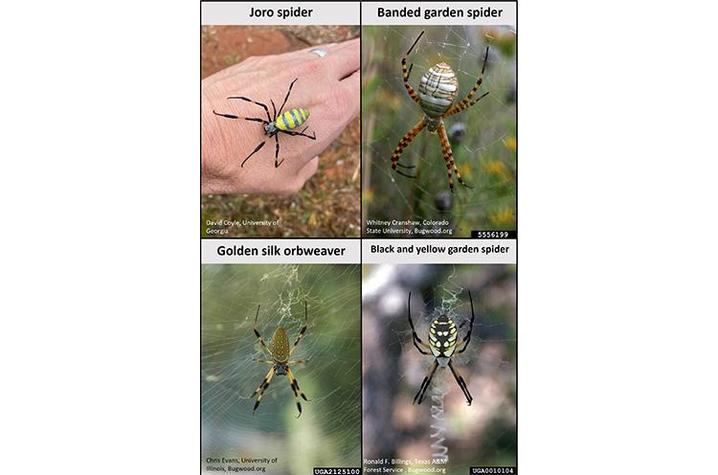UK Expert: Large Joro Spiders Likely Will Not Impact Kentucky

LEXINGTON, Ky. (March 18, 2022) — Joro spiders, which are the size of a human palm and can fall from great heights, should pose little concern for most Kentuckians. Jonathan Larson, University of Kentucky entomologist, does not expect the large spider to appear in the state this year.
“The Joro spider has attracted a lot national attention recently because of reports regarding its potential range expansion along the East Coast this summer and beyond,” said Larson, extension entomologist in the UK College of Agriculture, Food and Environment. “Its numbers have been growing since it was first found in 2014 in Georgia. Given the natural expansion rate of the spider, it is unlikely we will see it in the Bluegrass any time soon. Though, you never say never.”
A lot of the media attention regarding this spider has focused on their size and ability to “parachute” into new areas.
“It is a large spider, and their babies will ‘balloon’ into new areas, but this is true of how many of our native spider species disperse into new areas as well,” Larson said. “A big spider can’t float away on a silk strand. You won’t see spiders the size of a kid’s hand floating through the sky. It is just the ones that have emerged from eggs recently.”
While their size is imposing and may make some people shudder, Larson said the spiders are mostly harmless.
“Their venom is not considered medically important to people or pets, and like most spider species, they aren’t looking to bite things they can’t eat if they can help it,” he said. “Typically, the larger the spider, the less potent their venom.”
While it is worrisome that the non-native Joro spiders’ range is predicted to expand, little is known about how it will behave in new environments.
“It’s true that a potentially invasive species expanding its range like this is a cause for concern,” he said. “However, we’re still not 100% sure of the ecological impact of the Joro spider when it moves into new areas.”
One of the biggest annoyances reported by people living in areas where the spider is already established is the size of their webs. Joro spiders’ webs can be meters long and are stronger than the webs of native spiders. People may accidentally run into them and find them more annoying to untangle from.
Kentucky is home to several spiders that are similar to the Joro spiders in size and color. These include the banded garden spider, black and yellow garden spider and the golden silk orb weaver. Each of these spiders will have different colorations and leg fuzziness than the Joro spider. These spiders are also harmless to people and pets.
UK entomologists want to hear from those who suspect they have found a Joro spider in Kentucky so they can help identify the possible suspect. Individuals can submit spider photos for identification to UK entomology’s Kentucky Bugs Facebook page @kentuckybugs.
As the state’s flagship, land-grant institution, the University of Kentucky exists to advance the Commonwealth. We do that by preparing the next generation of leaders — placing students at the heart of everything we do — and transforming the lives of Kentuckians through education, research and creative work, service and health care. We pride ourselves on being a catalyst for breakthroughs and a force for healing, a place where ingenuity unfolds. It's all made possible by our people — visionaries, disruptors and pioneers — who make up 200 academic programs, a $476.5 million research and development enterprise and a world-class medical center, all on one campus.




